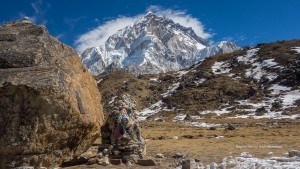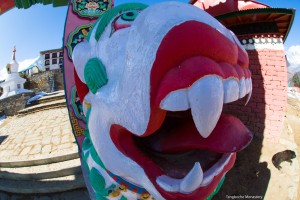

PHONE: 1 877 260 3950



So much has been written about Everest Base Camp Treks that it is hard to provide some original thinking on the topic. But, this did not stop me from trying. I reflected much on my experience and listed insights I felt could benefit those considering this epic Expedition. I eliminated those that can be readily found in the hundreds of blogs and reviews purporting to provide some informed wisdom on the trek. So here it goes:
1. Bring Children’s Clothes To Donate: I can’t claim credit for this idea because I learned it from a British couple while on safari in Tanzania. But, I don’t ever see this recommended anywhere, and it is such a good and simple idea, I had to include it. Quite simply, bring gently used children’s clothing and give it out along the trek. If you do not have a ready made stash of children’s clothing–like myself–then go to a local thrift store. The local peoples are extremely grateful for this small expression of generosity, and it makes an immediate, albeit small, impact on their lives.
2. Use Kathmandu “Knock Off” Gear At Your Own Peril: I overheard a gal proclaim that she didn’t believe her North Face sleeping bag–purchased in Kathmandu at a great discount–was the real thing. “And I am freezing at night,” she complained. Frankly, I was astonished by her comments. The Himalaya is a land of extremes. Your comfort, if not your physical safety, depends on your gear and apparel reliably providing the performance characteristics required for this environment. No gear or clothing–whether purchased in Kathmandu or at home–should be used for the first time on this trek.
3. Avoid Eating Meat Above Namche Bazaar: Everything–and I mean everything–has to be transported by person or animal from Lukla. For villages closer to Base Camp, this can take several days. Refrigeration is non-existent during transport, and meat can become adulterated en route. Don’t jeopardize your trek by contracting some food-borne illness. For protein, eat eggs and beans. You can also bring heavily preserved meat products like pepperoni or beef jerky.
4. North Face Base Camp Duffle Bags Are Best: These are beyond doubt the best bags to transport your gear and clothing. They are nearly ubiquitous, and for good reason. While not water proof, they do an excellent job protecting from the elements. They are easy for porters and animals to carry. They keep dust and dirt away from your equipment. They are very durable. The inside is easily accessed and secured by a stout zipper. I would not consider using anything else.
5. Energy gels and drink mixes: I carried two small packets of energy gel. I happen to like huma energy gel. It’s a chia based gel. They are an excellent boost when you are totally spent and trying to summon the strength to climb a steep, and seemingly endless grade like the one into Namche. Their energy to weight ratio, and durable packaging make them must-haves. If you are treating water with Iodine tablets, drink mixes can mask that chemical taste. And they can provide a constant dose of electrolyte and carbohydrate throughout the day, and offer a little variety to plain water (which you should be drinking lots of)
6. Skip Dingboche And Head To Dughla: Most cookie cutter itineraries put you in Dingboche after Tengboche (yes, there is lots of ‘boche’ in Khumbu Valley). Dughla makes more sense. Dingboche is up the eastern prong of a fork in the Imja Khola River. The route to Base Camp is up the western fork. So Dughla is more direct. And, a map recon reveals that Dingboche requires a few hundred meter climb into and out of the village. Avoiding that extra up and down didn’t seem like a bad idea! It makes for a longer day from Tengboche, but it is a wise choice if you are up for the longer segment.
7. In winter, consider an afternoon summit of Kala Patthar: Based on my summit attempt time of 0430, there are four compelling reasons to do it in the afternoon. Views of Everest are to the east, and the morning sun is blinding. With glacier glasses you can see just fine, but blinding sun makes taking clean photographs very hard. Second, the kitchen is closed that early, and you cannot eat the much needed fuel you will need. Third, 0430 ensured I was exhausted before I even started. Fourth, it is freakin’ cold that early. Ambient temps at my start time were -25C.
8. Tip Excessively, And Then Tip Some More: Porters are paid next to nothing, if not actually nothing. And the locals clamor for these jobs. They work extremely hard–almost unbelievably hard. They are charged with the responsibility of safekeeping your gear, and for securing accommodations at the lodges. I can’t remember exactly how much I tipped, but it was north of $100. My guide, Sudip, with Encounters Travel was truly extraordinary. And while he is paid more generously than porters, his wages are still quite modest. I tipped him about $200 by the end of my trek and tiger safari, a total of 12 days.
9. Porter Support Of Photography: For the photographer out there, unless you are an unusually strong climber, let your porter carry your kit. Porters typically bolt from the lodge in early morning, arriving at the next village well before you arrive. This enables them to secure better accommodation than if they arrived when you did—though this was a non-issue in February. I asked that the porter stop periodically along the trail so that we could catch up and have access to my camera kit. This worked just fine. Obviously, take great lengths to pack and insulate your gear to guard against damage.
10. Urine Bottle: At night, lodges are frigid and dank. Save yourself the turmoil of negotiating those conditions just to hit the head in the middle of the night. Instead, unzip your bag and reach for the pee bottle. I took the time to Sharpie the word “pee” on it. You can’t be too careful with stuff like that!
11. Strip Pack Down: The air pressure is much lower here, so there is less breathable oxygen. This causes fatigue more quickly. Your body will eventually adjust through the acclimatization process, but until then, do everything to reduce your pack weight, even if just by a few grams. I highly recommend removing all unnecessary pack straps, plastic parts, cords, and foam. Yes, that brand new Osprey pack needs a shave. I would lose the hip belt too. I humped the old-school Kelty Redwing 50, an awesome pack due to its capacity and ease of access to the main compartment. It is on the heavier side. I now use the Gregory Miwok 34, which I highly recommend.
12. Satellite Phone: Wifi can be spotty, particularly the further up you go. During the winter months, many lodges simply discontinue internet service. Satellite phones have come down in price, and cost as much as an iPhone now. I really like the Inmarsat Isatphone 2 because of its extremely long battery life. You can buy data and voice at affordable rates. You can text, email, and talk. I find this to be a very reliable mode of communication in remote areas like the Khumbu Valley.



* * *
This is my concluding post on Everest Base Camp. It was truly an extraordinary experience. It pushed my mental and physical stamina to their limits. It was an epic Expedition, one that I hope you can enjoy too. For more about my Everest Base Camp Trek and other Expeditions, please visit www.navigationjason.com.
Need some travel inspiration or looking for some handy travel tips? Our blog provides excellent insight into our travel destinations - from tour updates to country guides, packing lists to little known things to do, you'll find it all in our travel blog.